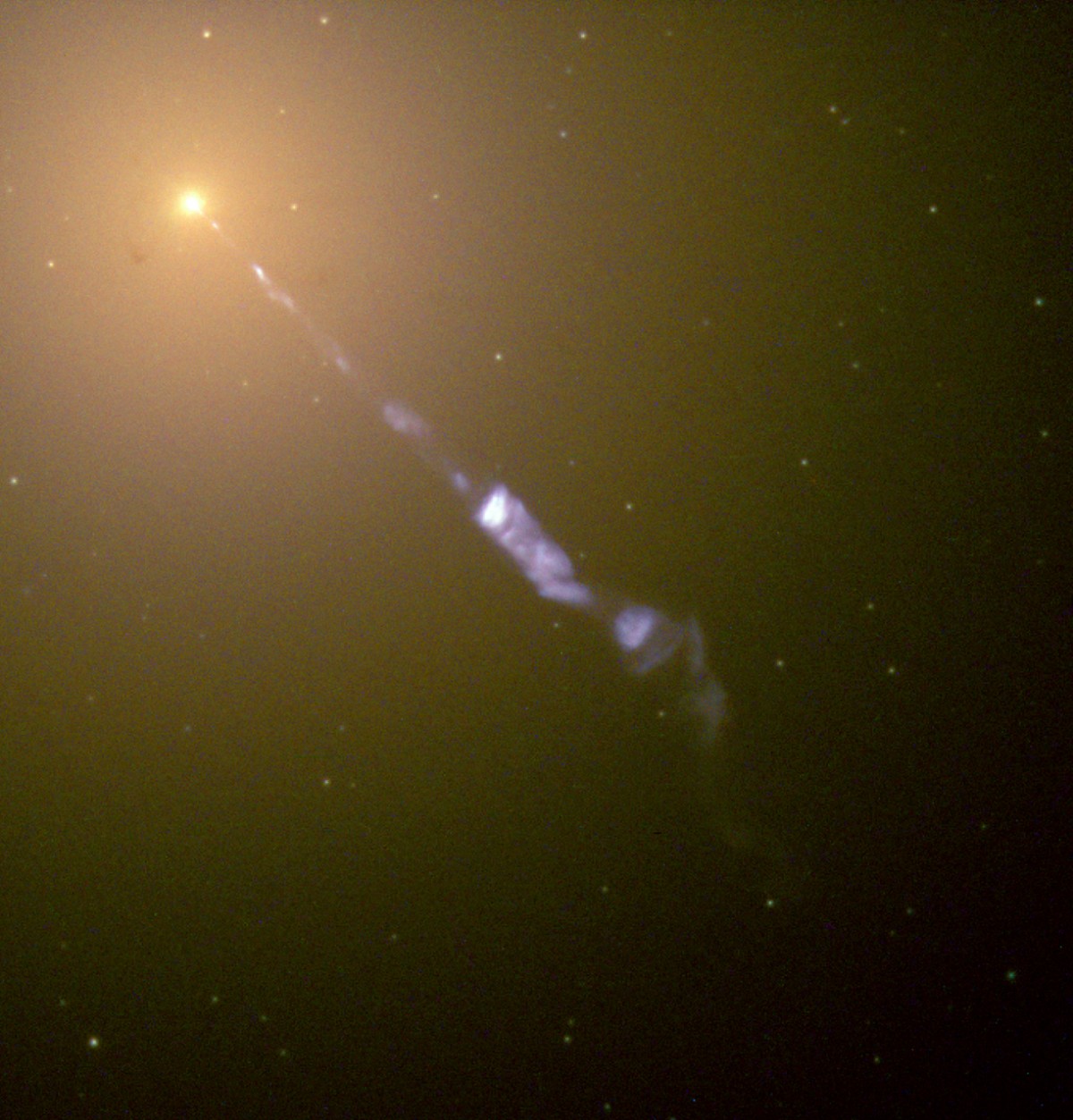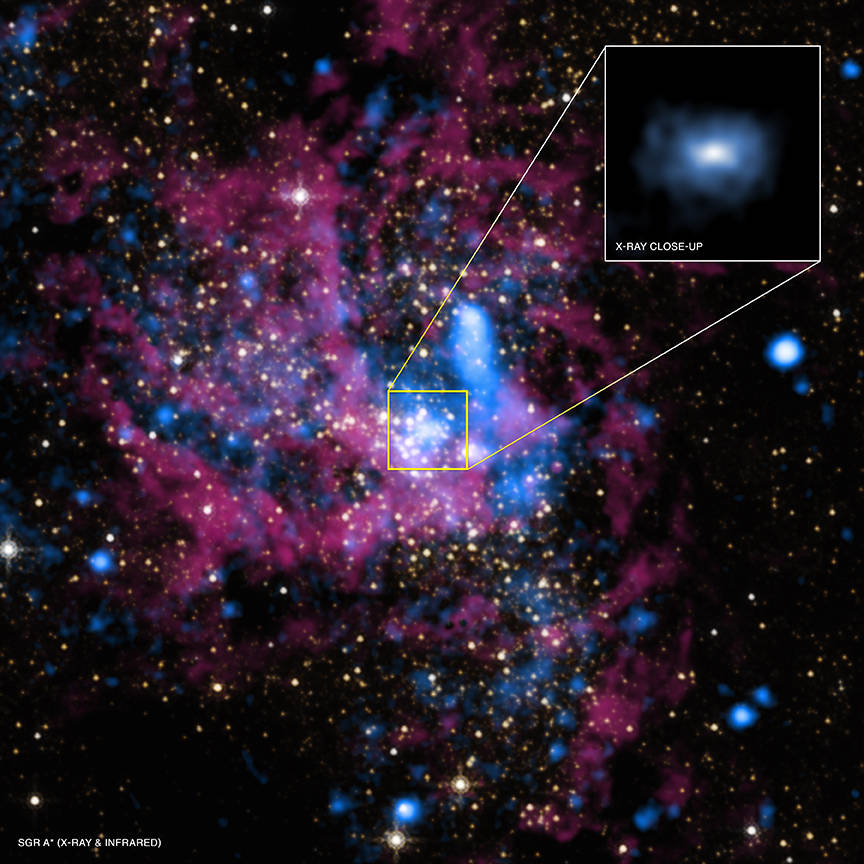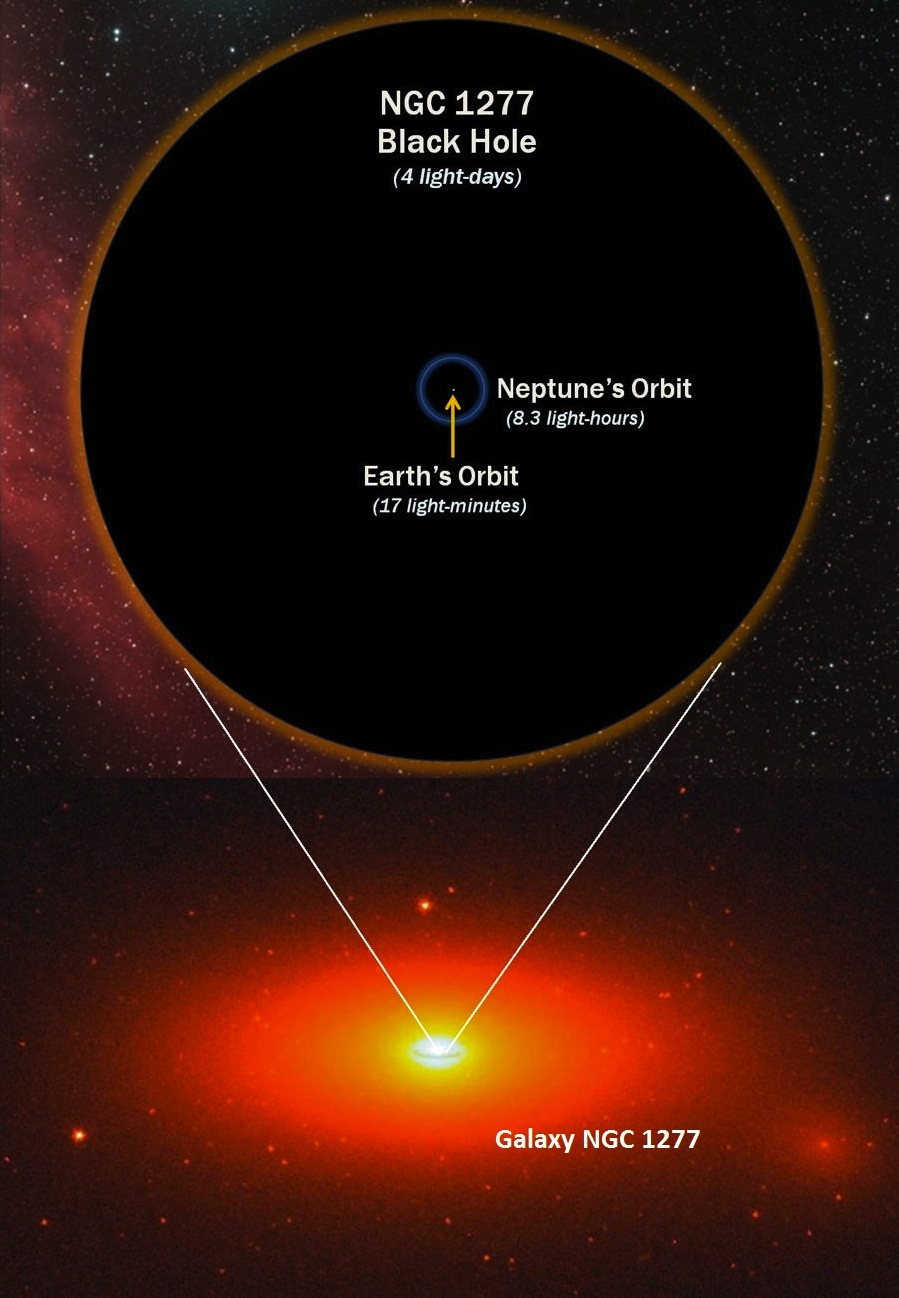Ask Ethan # 114: Can we see a supermassive black hole in the center of our galaxy?
One of the most amazing discoveries of astrophysics was the discovery of giant black holes. It turned out that black holes are formed not only from the collapsed nuclei of very massive stars weighing up to 100 solar ones.

Supermassive black holes that exist in the centers of galaxies have a mass of millions, and sometimes billions of times greater than the sun. Such a BH exists in the center of our galaxy. So far, it could only be observed indirectly, but this does not suit our reader, who asks:
To begin, let us tell you how we know about the existence of a black hole in the center of our galaxy.

')
In visible light, a large amount of dust that exists in the plane of the galaxy, closes our view of the center of the galaxy. But at other wavelengths, infrared, X-ray and radio, we can see through the dust and discover many interesting things, including hot gas moving at tremendous speeds, flashes corresponding to the absorption of the BH matter, and most interestingly, the orbits of individual stars pass around the same same point, not emitting light at all.
Everything is consistent with the fact that at this point is a supermassive black hole weighing 4 million solar. And the more BH is massive, the larger it is. Or, more precisely, physically, its event horizon is larger — the region surrounding it, from which light cannot escape. If our Earth suddenly turned into a BH, it would become tiny: the diameter of its event horizon would be only 1.7 cm. In the case of the Sun, this diameter would be already 6 km.
And the diameter of the horizon of events of a supermassive BH in the center of the Galaxy is 23.6 million km, or 40% of the size of the Mercury orbit around the Sun. In other galaxies, there are much larger BHs. Simply, they are from us in the millions, not thousands of light years.

For an individual object, this is a very large size, and the effects of the General Theory of Relativity, which cause space to bend, only increase it! But although the size of this object is gigantic, it is extremely far from us, which is why it is very difficult to consider. At a distance of 26,000 light years, the apparent size of the BH will be only 19 angular microseconds, or 19 ppm from one-sixtieth of one-sixtieth of a degree. To introduce this, let's say that the resolution of the space telescope to them. Hubble is 26 angular milliseconds, which is more than 1000 more than necessary to see this BH.

In Theory, if we get closer to it, at a distance of several hundred light years, we can see it directly. But it is practically impracticable. However, we have one technology that can allow us to circumvent this limitation. At some wavelengths, in particular, radio and X-ray, the black hole can sometimes flare up brightly, or the objects passing next to it can highlight the event horizon from behind.
The maximum resolution is determined by the size of the telescope's mirror — how many wavelengths can fit across this mirror. Therefore, the resolution of the X-ray telescope Chandra is very large, although it is small: the X-ray has a very small wavelength, and there are many such waves across the mirror. Therefore, radio telescopes are so huge: radio waves can reach several meters, and huge telescopes are required to obtain good resolutions.



Radio telescopes at the Pushchino radio astronomy observatory
But for more resolution, there is a workaround that does not require the construction of a telescope the size of the Earth. We can use a set of telescopes separated by very large base lines. They will collect light as usual, that is, the object will be rather dim, but their resolution will be the same as that of a telescope with a mirror, the diameter of which is comparable to the distance between the most distant telescopes from the array!

This is exactly the idea that the Event Horizon Telescope project, which plans to use large baselines for short wavelengths (1 mm) for the measurement we are interested in, implements! So far there are two proposals - for an array of 7 and of 13 stations, each of which would answer the question “does the BH have a real event horizon” by observing the BH directly!

Sagittarius A *, a BH in the center of the Galaxy, is an ideal target, and it is expected that it will have the largest event horizon visible from Earth. It's funny that the BH in the center of M87, the largest galaxy in the Virgo cluster, should be the second in size, and its size will be 5 times larger than the maximum resolution of the Event Horizon Telescope, which means that we can examine its jet in detail and understand exactly how supersonic emissions form and behave!
But if the question was related to the use of your eyes, if you yourself wanted to see a BH - I will have to disappoint you.

The resolution of the human eye is trivial, it is only 60 arc-seconds, that is, to see something whose apparent size is 19 angular microseconds, you need to be three million times closer to it, that is, to get close to 546 AU. The nearest star is the sun, and the next is Proxima Centauri, it is 4.24 light years, or 268,000 AU. Yes, yes, you would need to be 500 times closer to BH than to the star closest to us (except the Sun), only to even consider anything at all.
I recommend using telescopes. This is both faster and cheaper, and safer than interstellar travel - and more useful, since with their help one can see much more than with the help of the eyes.

Supermassive black holes that exist in the centers of galaxies have a mass of millions, and sometimes billions of times greater than the sun. Such a BH exists in the center of our galaxy. So far, it could only be observed indirectly, but this does not suit our reader, who asks:
As I understand it, in the center of our galaxy there is a massive black hole. How close should you get to her to see? I think it is not necessary to be too close to the event horizon, but since there are so many stars around it, and all the dust and debris are sucked in it, you can hardly see it from a sufficiently long distance, even if it is above or below the galactic plane.
To begin, let us tell you how we know about the existence of a black hole in the center of our galaxy.

')
In visible light, a large amount of dust that exists in the plane of the galaxy, closes our view of the center of the galaxy. But at other wavelengths, infrared, X-ray and radio, we can see through the dust and discover many interesting things, including hot gas moving at tremendous speeds, flashes corresponding to the absorption of the BH matter, and most interestingly, the orbits of individual stars pass around the same same point, not emitting light at all.
Everything is consistent with the fact that at this point is a supermassive black hole weighing 4 million solar. And the more BH is massive, the larger it is. Or, more precisely, physically, its event horizon is larger — the region surrounding it, from which light cannot escape. If our Earth suddenly turned into a BH, it would become tiny: the diameter of its event horizon would be only 1.7 cm. In the case of the Sun, this diameter would be already 6 km.
And the diameter of the horizon of events of a supermassive BH in the center of the Galaxy is 23.6 million km, or 40% of the size of the Mercury orbit around the Sun. In other galaxies, there are much larger BHs. Simply, they are from us in the millions, not thousands of light years.

For an individual object, this is a very large size, and the effects of the General Theory of Relativity, which cause space to bend, only increase it! But although the size of this object is gigantic, it is extremely far from us, which is why it is very difficult to consider. At a distance of 26,000 light years, the apparent size of the BH will be only 19 angular microseconds, or 19 ppm from one-sixtieth of one-sixtieth of a degree. To introduce this, let's say that the resolution of the space telescope to them. Hubble is 26 angular milliseconds, which is more than 1000 more than necessary to see this BH.

In Theory, if we get closer to it, at a distance of several hundred light years, we can see it directly. But it is practically impracticable. However, we have one technology that can allow us to circumvent this limitation. At some wavelengths, in particular, radio and X-ray, the black hole can sometimes flare up brightly, or the objects passing next to it can highlight the event horizon from behind.
The maximum resolution is determined by the size of the telescope's mirror — how many wavelengths can fit across this mirror. Therefore, the resolution of the X-ray telescope Chandra is very large, although it is small: the X-ray has a very small wavelength, and there are many such waves across the mirror. Therefore, radio telescopes are so huge: radio waves can reach several meters, and huge telescopes are required to obtain good resolutions.



Radio telescopes at the Pushchino radio astronomy observatory
But for more resolution, there is a workaround that does not require the construction of a telescope the size of the Earth. We can use a set of telescopes separated by very large base lines. They will collect light as usual, that is, the object will be rather dim, but their resolution will be the same as that of a telescope with a mirror, the diameter of which is comparable to the distance between the most distant telescopes from the array!

This is exactly the idea that the Event Horizon Telescope project, which plans to use large baselines for short wavelengths (1 mm) for the measurement we are interested in, implements! So far there are two proposals - for an array of 7 and of 13 stations, each of which would answer the question “does the BH have a real event horizon” by observing the BH directly!

Sagittarius A *, a BH in the center of the Galaxy, is an ideal target, and it is expected that it will have the largest event horizon visible from Earth. It's funny that the BH in the center of M87, the largest galaxy in the Virgo cluster, should be the second in size, and its size will be 5 times larger than the maximum resolution of the Event Horizon Telescope, which means that we can examine its jet in detail and understand exactly how supersonic emissions form and behave!
But if the question was related to the use of your eyes, if you yourself wanted to see a BH - I will have to disappoint you.

The resolution of the human eye is trivial, it is only 60 arc-seconds, that is, to see something whose apparent size is 19 angular microseconds, you need to be three million times closer to it, that is, to get close to 546 AU. The nearest star is the sun, and the next is Proxima Centauri, it is 4.24 light years, or 268,000 AU. Yes, yes, you would need to be 500 times closer to BH than to the star closest to us (except the Sun), only to even consider anything at all.
I recommend using telescopes. This is both faster and cheaper, and safer than interstellar travel - and more useful, since with their help one can see much more than with the help of the eyes.
Source: https://habr.com/ru/post/399977/
All Articles